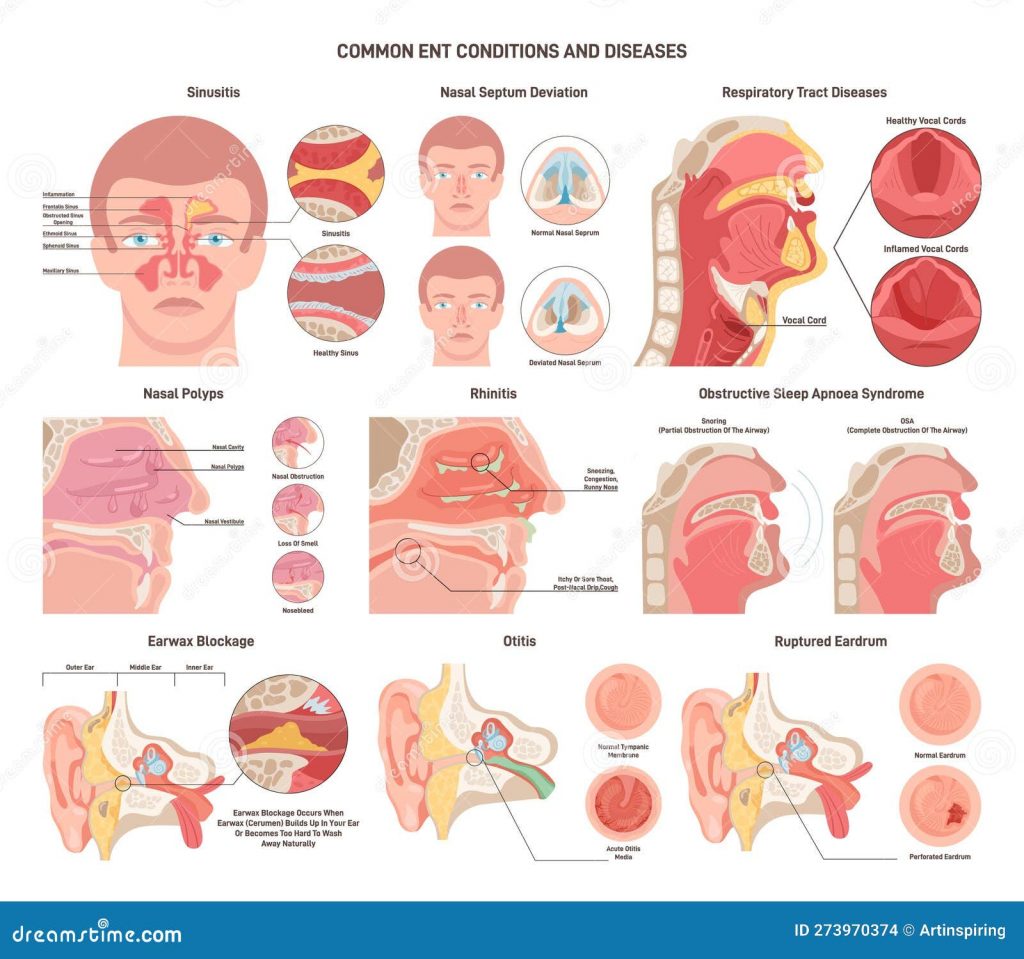The ears and nose are essential parts of our body, as they assist us in balancing our oxygen intake and several different functions of our body, so it’s necessary to keep them healthy. We should make sure that they are in top shape for daily function. Keeping up with your fitness can be a problem when you have nose and ear conditions.
Here are some nose and ear medical conditions that can affect your fitness:

Ear Infection
Acute otitis media is an ear infection that is more commonly found in children than in adults. It is caused by either bacterial or viral infection that affects the middle ear. The middle ear is a space behind your eardrum that houses the vibrating bones in our ears.
Here are common symptoms of nose and ear conditions found in children and adults:
- Headache
- Loss of balance
- Appetite loss
- Trouble sleeping
- Hearing problems
- Fluid draining from the ear
- Ear pain
If symptoms continue for two days or longer, you should consider talking to your doctor. Ear infections are caused by a number of factors and can cause severe pain and sleep issues.
Ear infections are diagnosed by a doctor using an otoscope to check at areas like the throat, ears, and nasal passage. However, in severe cases the doctor will need to perform extra tests. When an infection on the ear is diagnosed, it can fall under any of these categories:
- Chronic suppurative otitis media: Commonly diagnosed following an upper respiratory tract infection. It’s a chronic inflammation of the middle ear and mastoid cavity where there is a torn or perforated eardrum.
- Acute otitis media: Commonly diagnosed when your doctor notices evidence of infections and fluids in the ear.
- Otitis media with effusion: Commonly diagnosed if there’s signs of non-infected fluid accumulation in the middle ear as a result of a sore throat, cold, or respiratory infection.
Ear infections can be treated without any medical attention or treatment depending on the severity of the infection. Some procedures can include:
- Antibiotics: Your doctor will recommend this for various ear infection cases.
- Pain management: Your doctor will advise warm compress or the use of over-the-counter medications for pain relief.
- Ear tubes: This treatment is used when the doctor needs to extract fluid from people who have chronic ear infections.
If symptoms continue to persist, you can speak to an ENT specialist from Central Park ENT to learn more about us and your medical condition. This medical treatment is also available today in other countries like Singapore where they produce Ear Nose Throat Specialist to help patients with the said disorders.
Sinusitis
Sinusitis is caused by the inflammation and infection in the sinuses – the cavities within the face that branch off from your nasal cavities. According to the Center for Disease Control and Prevention, there are 26.9 million adults diagnosed with sinusitis and it’s one of the most common medical conditions in the United States.
Here are some common symptoms of sinus infections:
- Greenish nasal discharge
- Nasal congestion
- Frontal headaches
- Tenderness under the eyes or bridge of the nose
- Coughing
- Fever
- Fatigue
- Bad breath
- Postnasal drip
Sinusitis is sometimes confused with rhinitis – a medical term for symptoms that accompany nasal irritation and inflammation. It only involves the nasal passages and can be caused by allergies and colds.
Diagnosis will require examination of the nose, throat, and sinuses. Your doctor will look for symptoms like:
- Swelling of the nasal tissues
- Tenderness of the face
- Discolored nasal discharge
- Redness
- Bad breath
If your sinusitis continues for longer than eight weeks, or if the antibiotic treatment is not working, a CT scan of your sinus may help your doctor diagnose the problem.
Treatment for sinusitis include the following:
- Antibiotics: a standard treatment for sinus infections caused by bacteria. It’s usually taken for 3 to 28 days depending on the type of antibiotic. Longer antibiotic medications may be prescribed for severe cases.
- Antihistamines: Antihistamines can block inflammation caused by an allergic reaction.
- Nasal decongestant spray: Topical nasal decongestants can help shrink swollen nasal passages, allowing the flow of drainage from the sinuses. However, overuse of topical decongestants can result in a condition called rebound phenomenon.
- Topical nasal corticosteroids: These prescription nasal sprays reverse and prevent swelling and inflammation in your sinus openings and nasal passages. It also shrinks and prevents the return of nasal polyps and can be used for more extended periods without developing drug dependence.
- Surgery: If medications don’t work, surgery may be the last resort. Your otolaryngologist can fix defects on your bone separating the nasal passages, removing the nasal polyps, and opening up the clogged passages. The surgery will be performed under local or general anesthesia, and patients usually go home on the same day.
Conclusion
Keeping up your fitness with these medical conditions can be tough as it’s hard to breathe if you have a sinus infection or othere nose and ear conditions especially when running, or keeping your balance when you have an ear infection. Use this guide to prevent these medical conditions and if professional care is needed, always seek the advice of your family doctor.








